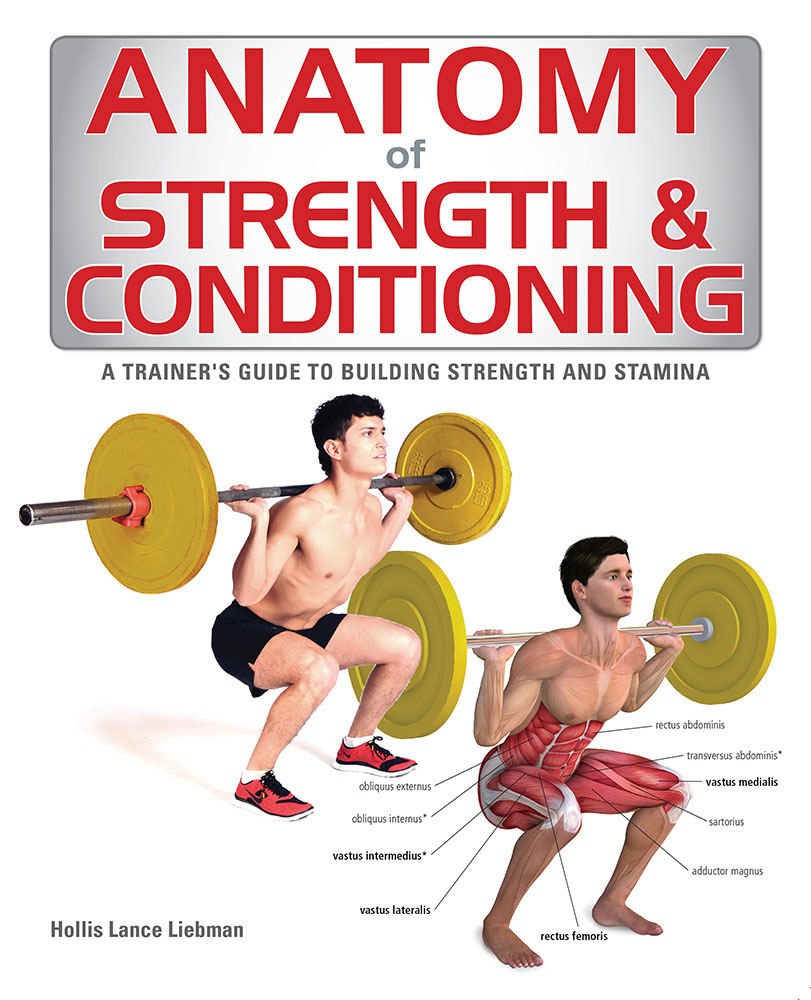STRENGTH SENSEI BOOKSHELF
Anatomy of Strength & Conditioning
A beginner’s guide to what muscles work with weight training
If you’re serious about designing the best workout for you, or if you’re a trainer who is designing workouts for others, you need to know about muscles. Not just how muscles are attached to points A and B, but how they work in popular weight training exercises.
The problem is many anatomy books recommended for trainers are too complex. Seeing a photo of a squat with dozens of muscles highlighted doesn’t provide much useful information to help trainers design workouts. Nor do they help a trainer explain what muscles are being worked in popular weight training and general fitness exercises, such as those using Swiss balls. Anatomy of Strength & Conditioning by Hollis Lance Liebman (2014) solves these issues, particularly for those new to the strength training with no formal education in anatomy.
Take the example of the barbell shoulder shrug. Asked what muscles this exercise works, a typical trainer might say “traps.” In this Liebman’s, the section on this exercise begins with photos showing the start, mid-point (i.e., peak contracted), and finish of the exercise. This is followed by a description of how to perform it.

From here, Liebman discusses the following: What muscles are strengthened (Targets), the value of the exercise (Benefits), a training tip (Do It Right), common errors (Avoid), and what muscles the exercise is commonly used for (Best For).
Next is an anatomy drawing showing the mid-point of the exercise, similar to what you would see in traditional weight training anatomy books. But what sets this book apart is that all these muscles are shown in another drawing, highlighting those targeted the most. Finally, the author provides an alternative version of the exercise, specifically the dumbbell shoulder shrug, along with a photo of the exercise.
Such information may be just what the typical trainer (or weight trainer) needs to help them design workouts. Or it can be used as a starting point to explore more detailed books such as those by Frédéric Delaviere, particularly Strength Training Anatomy and Women’s Strength Training Anatomy (published by Human Kinetics).
Although the book is large (160 pages for the paperback and 411 for the Kindle), only 29 weight training exercises are examined. Other exercises are Warm-up Exercises, Stretching Exercises, and conditioning exercises (including plyometrics movements). However, this book is part of a series by Firefly Books. One book in the series that focuses more on bodybuilding exercises is Anatomy of Muscle Building by Craig Ramsay
Putting everything together, the author concludes with six workouts to show how a program can be designed, as follows:
Beginner’s Workout
Sports Workout
Mixed-Modalities Workout
Range Workout
Melting-Pot Workout
Kamikaze Workout
These workouts are seriously lacking. A beginner’s workout shows five exercises: Barbell Squats, Barbell Deadlift, Bench Press, Standing Barbell Press, and Dip. No guidelines on loading parameters such as sets, reps, and rest periods. Also, such a workout is rather odd, such as squats and deadlifts in the same workout, and no upper body horizontal or vertical pulling movements (other than a deadlift).
Other than the lame workouts, Anatomy of Strength & Conditioning provides a good starting point for learning about practical anatomy for weight training for trainers and the general population. It’s the type of book that could be useful for a high school weight training class. It’s not the only book you need on strength training anatomy, but it’s a good start! (TSS)
[Anatomy of Strength & Conditioning by Hollis Lance Liebman is available in paperback and Kindle versions through Amazon.com.]
